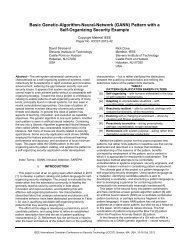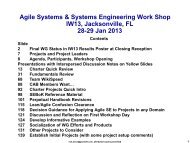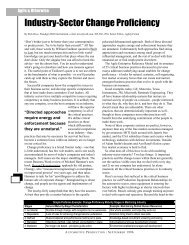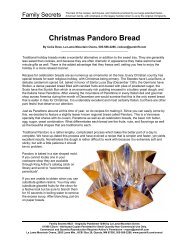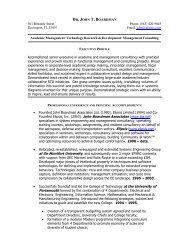Joe Justice: Managing a Collaborative Multi-National Team in Real ...
Joe Justice: Managing a Collaborative Multi-National Team in Real ...
Joe Justice: Managing a Collaborative Multi-National Team in Real ...
You also want an ePaper? Increase the reach of your titles
YUMPU automatically turns print PDFs into web optimized ePapers that Google loves.
62:15 Q: To help fund WikiSpeed, where can e get a T-shirt with the Gorilla high fiv<strong>in</strong>g the shark. A: ….<br />
64:30 Q: What is your longer term vision for the care manufacturers. Do you see this scal<strong>in</strong>g up to a larger car<br />
manufacturer. Would it then turn <strong>in</strong>to a for-profit car operation. A: …Were not aga<strong>in</strong>st profit but that’s not what we do<br />
…….we want to make a difference for the environment … more customer relevant, more environmentally susta<strong>in</strong>able,<br />
and lower overall cost of ownership, we’ve done the right th<strong>in</strong>g. We see all of our current competitors as future<br />
partners.<br />
69:43 Q: I’ve been coach<strong>in</strong>g, so fac<strong>in</strong>g the pa<strong>in</strong> of transformation, and view this work as disruptive. What do you see<br />
of current manufactures succeed<strong>in</strong>g with this <strong>in</strong>stead of new disruptive manufacturers grow<strong>in</strong>g up around them and<br />
eat<strong>in</strong>g their lunch? A: That’s Steve Denn<strong>in</strong>g’s po<strong>in</strong>t exactly, if I followed you. He’s say<strong>in</strong>g it’s very pa<strong>in</strong>ful for an<br />
exist<strong>in</strong>g organization to change methods, and so what seems to be happen<strong>in</strong>g, and what has historically happened, <strong>in</strong><br />
the pace of bus<strong>in</strong>ess turnover that’s accelerat<strong>in</strong>g, is that some other company comes up, is radically disruptive, takes<br />
over the space, and then they become the complacent one. Then they’re raided and disrupted, and they’re raided and<br />
disrupted. My guess at what the answer is, what I’ve observed and have some evidence of what the answer might be,<br />
is that companies need to be good at change. Not be good at agile, not be good at scrum, not be good at l<strong>in</strong>e<br />
manufactur<strong>in</strong>g, not be good at lean, although all those th<strong>in</strong>gs do help them change quickly; but the actual good is not<br />
to figure out how to be an awesome scrum master. The actual good is to figure out how to make your team do<br />
someth<strong>in</strong>g different next week that’s better than what you’re do<strong>in</strong>g now. That’s what all these practices are all about.<br />
We all know this. But sometimes it’s easy to get dogmatic, and we know when that happens, the excitement starts to<br />
leave the team. The other part of that is, if there’s anyth<strong>in</strong>g <strong>Team</strong> WikiSpeed is do<strong>in</strong>g that’s actually new – because<br />
everyth<strong>in</strong>g we’re do<strong>in</strong>g is common across the agile space, it’s just the agile space is still boom<strong>in</strong>g, it’s still fly<strong>in</strong>g open<br />
and expand<strong>in</strong>g – is focus<strong>in</strong>g on moral as a multiplier for velocity. That’s not very common yet. I’ve heard a few<br />
sessions about it [here at the conference], and I didn’t come up with it either. But we apply that very seriously, and<br />
we apply that paired with reduced cost to make change. I bet that that’s what might serve these companies, be<strong>in</strong>g<br />
good at hav<strong>in</strong>g highly motivated teams that are mak<strong>in</strong>g changes quickly. They may be able to stay on top of their<br />
markets. But that doesn’t address how to conv<strong>in</strong>ce or encourage or support an exist<strong>in</strong>g company try to make change.<br />
There’s the thought that you have to give someone at least five compliments before you can ask them to change. It<br />
might be f<strong>in</strong>d<strong>in</strong>g out what’s really good about the companies we’re <strong>in</strong> before we f<strong>in</strong>d out what we might want to<br />
disrupt, and disrupt it very gently, and with support. And come at it, I amag<strong>in</strong>e, from a lov<strong>in</strong>g angle at what the<br />
company’s already good at, and a lov<strong>in</strong>g angle for the people <strong>in</strong> the bus<strong>in</strong>ess and what they’re already do<strong>in</strong>g, and help<br />
them do it better – to be higher morale, and to be able to make changes quickly. Then maybe we will see all<br />
companies be<strong>in</strong>g cont<strong>in</strong>ually disruptive. And we’ll all benefit from hav<strong>in</strong>g a radically different, maybe, pace of new<br />
product development that is customer focused. Did that talk to your question at all or did I go sideways and talk <strong>in</strong> a<br />
rant?<br />
72:42 Q quy responds: No, actually that was really good. But I th<strong>in</strong>k when you were talk<strong>in</strong>g there about, um, some<br />
people th<strong>in</strong>k I’m a nice guy. I’ve got them fooled. When you’re look<strong>in</strong>g at try<strong>in</strong>g to transform them, it seems to take<br />
an awful long time. So they th<strong>in</strong>k “I’m go<strong>in</strong>g to get this coach <strong>in</strong>, and oh by the way I want you to take these hundred<br />
teams and get them agile before the end of the year.” I just k<strong>in</strong>d of start to shiver and shake when I hear them talk<br />
that way, because it’s a lot of talk<strong>in</strong>g, help<strong>in</strong>g. When they feel like you’re there to help, then you get the ability to<br />
<strong>in</strong>fluence them. And that, to me, takes a long time to be able to build that up. That’s my fear, of them not actually<br />
transform<strong>in</strong>g. Then it takes a 2x4 to the head and that’s a lot more pa<strong>in</strong>ful for them then a nice transformation.<br />
73:39 A: I used to feel that level of resistance at the clients I’d go to <strong>in</strong> my day job. I don’t any more. That example<br />
at Tait radio – they were already do<strong>in</strong>g some strong practices that they had found by work<strong>in</strong>g with Mary and Tom<br />
Poppendieck, and Henrick [Kniberg] . Then when Tim Meyer and I were able to come <strong>in</strong>, we were able to set up a<br />
team on day one. We were able to have visible, radical progress <strong>in</strong> that team. The team was, and Tim and I were able<br />
to support it (we didn’t build those radios, we’re not radio eng<strong>in</strong>eers) <strong>in</strong> five days. We’re beg<strong>in</strong>n<strong>in</strong>g to see the pace of<br />
adoption, the pace of culture change, go through the roof too. What I see as a – I will get on my high horse for a just<br />
a m<strong>in</strong>ute – is I see people come <strong>in</strong> and talk about organizational change as if it’s this road map <strong>in</strong> this cycle. What?<br />
We’re agile.<br />
[excitedly] I run <strong>in</strong>to a client and say “You have permission to do what you need to do. They do, right? [said<br />
sideways, to management presumably]. Okay – and you won’t be fired for at least one week. Now we’re go<strong>in</strong>g to<br />
do someth<strong>in</strong>g really different and here’s the practices that support it. See that Q ball, just for this week, we’re<br />
go<strong>in</strong>g to move it aga<strong>in</strong>st the wall, okay? Please take these th<strong>in</strong>gs over here . Who has the clearest vision of what<br />
we’re do<strong>in</strong>g? Who can imag<strong>in</strong>e a day <strong>in</strong> the life of the customer,a nd what they’re do<strong>in</strong>g that day when they’re<br />
us<strong>in</strong>g your product or service, and what they ate for breakfast, and how it relates to the rest of the t<strong>in</strong>gs they do<br />
that day? Who is that? It’s your tester?! Oh wow, imag<strong>in</strong>e that, it’s not even someone from market<strong>in</strong>g but they<br />
really do. Do they? They do. Let’s talk about how to vote as a team. You’re now this th<strong>in</strong>g called the product<br />
owner. Who’s go<strong>in</strong>g to run get everybody screwdrivers and lemonade? Okay, for today at least you’re the scrum<br />
master. Do you have a background <strong>in</strong> team psychology? No. Well maybe go to a coach<strong>in</strong>g cl<strong>in</strong>ic next week.<br />
Week one we have results. That starts to have people from other teams come <strong>in</strong> and look, say<strong>in</strong>g “what’s go<strong>in</strong>g<br />
on.” And we have an all hands session say<strong>in</strong>g everyth<strong>in</strong>g you gave this team once a year, you’re no go<strong>in</strong>g to give<br />
them a little piece of it once a week, and everyth<strong>in</strong>g you used to get from this team once a year, once a quarter,






